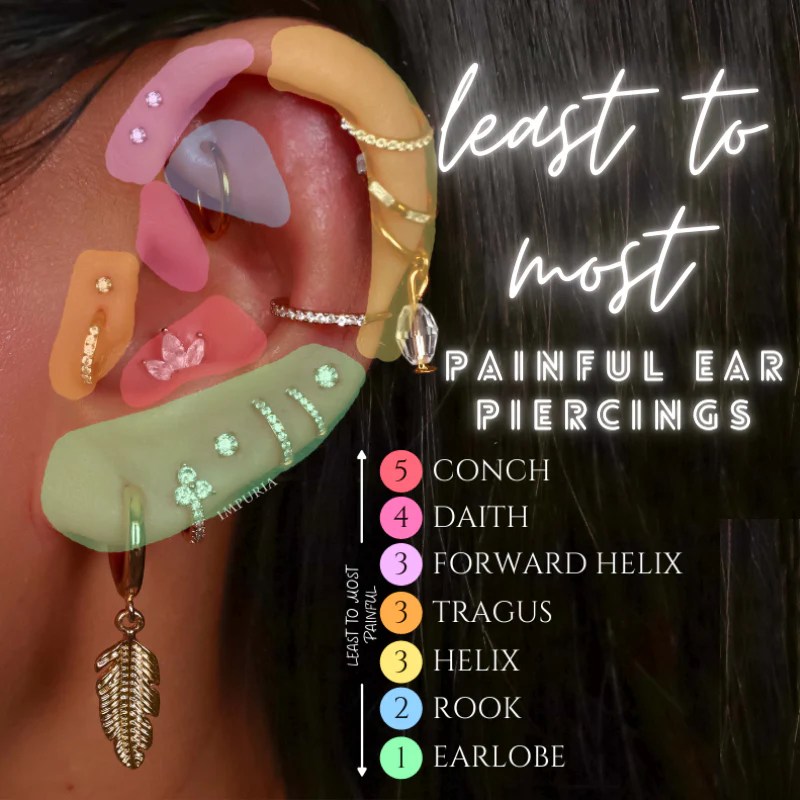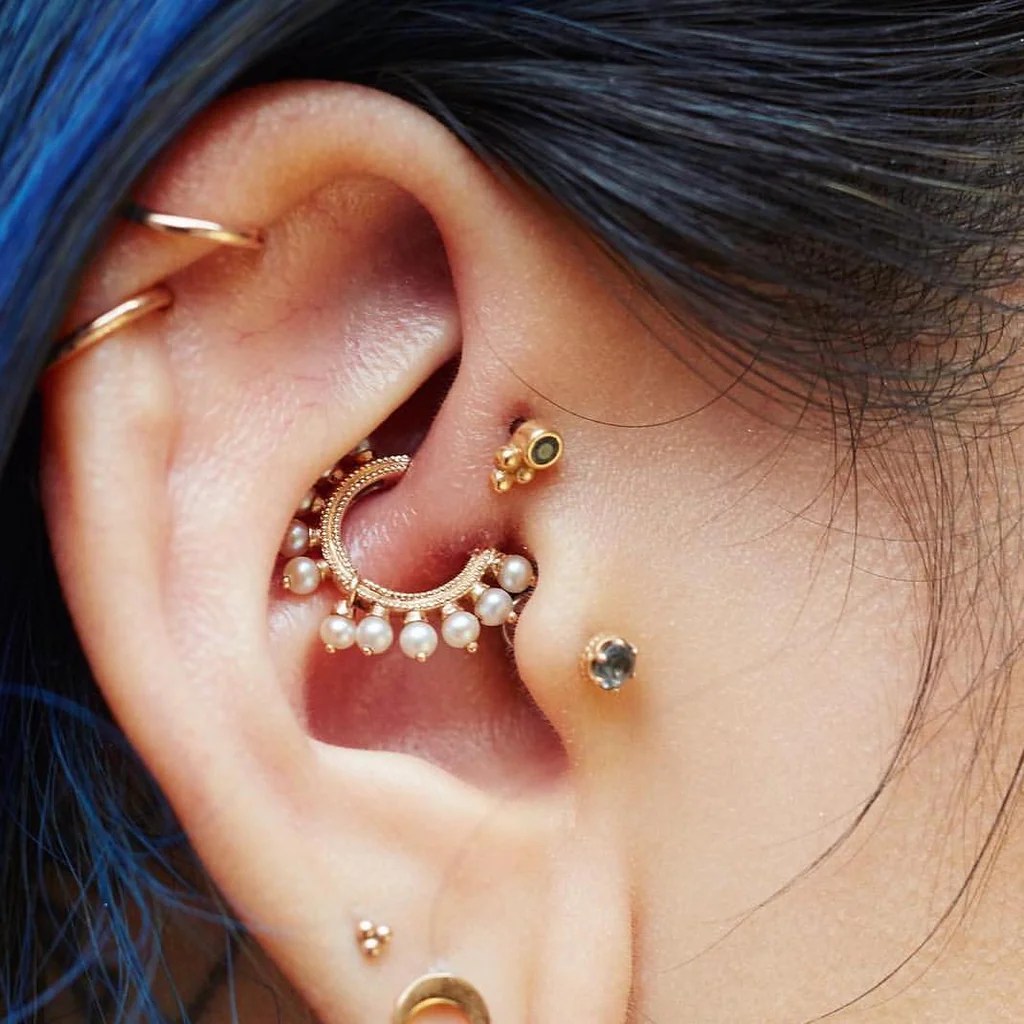Getting your ears pierced can be an exciting experience, but it also comes with varying levels of pain. When it comes to ear piercings, not all locations are created equal, and some can be quite painful. Understanding the most painful ear piercings can help you make an informed decision about where to get your ears pierced. In this article, we will explore the different types of ear piercings, the pain levels associated with each, and tips for managing discomfort during the process. By the end, you will have a comprehensive understanding of what to expect from your ear piercing journey.
In addition to pain levels, we will also discuss aftercare tips to ensure a smooth healing process. Piercings require proper care to prevent infections and complications, and knowing how to take care of your new piercings will contribute to a positive experience. Whether you're a first-timer or looking to add more jewelry to your collection, this guide will provide valuable insights.
Let’s dive into the world of ear piercings and uncover which ones can be the most painful and why. We will look at the anatomy of the ear, factors that influence pain levels, and personal experiences to give you a well-rounded view of the topic. So, if you're considering an ear piercing, keep reading!
Table of Contents
Anatomy of the Ear: Understanding Pain Sensitivity
The ear is a complex structure made up of various components, including cartilage, skin, and nerve endings. Different areas of the ear have different levels of sensitivity due to the density of nerve endings in each region. This sensitivity significantly impacts the pain experienced during a piercing.
When considering an ear piercing, it is essential to understand the anatomy involved:
- Outer Ear: This includes the earlobe and the outer cartilage. The earlobe is typically the least painful area to pierce.
- Cartilage: Areas such as the helix and tragus are made of cartilage, which is denser and contains more nerve endings, leading to increased pain.
- Inner Ear: Although not typically pierced, it's important to note that this area contains the most sensitive structures and is not a common area for piercings.
Pain Levels of Different Ear Piercings
When it comes to ear piercings, pain levels can vary widely based on individual pain tolerance, the location of the piercing, and the method used. Here is a general overview of pain levels associated with various ear piercings:
- Earlobe Piercing: Generally considered the least painful, with a pain level rated around 1-2 out of 10.
- Cartilage Piercings (Helix, Tragus): Pain levels can range from 4-7 out of 10, depending on the specific location.
- Industrial Piercing: Often rated around 6-8 out of 10 due to the complexity of the procedure.
- Daith Piercing: Pain level typically falls between 5-7 out of 10, as it involves piercing through thick cartilage.
The Most Painful Ear Piercings
Let’s explore the most painful ear piercings in detail:
1. Tragus Piercing
The tragus is the small flap of cartilage that covers the ear canal. Piercing this area can be quite painful due to the thickness of the cartilage and the numerous nerve endings present. Pain levels are often rated between 6-8 out of 10.
2. Helix Piercing
Located on the outer ear cartilage, the helix piercing can also be painful, particularly if multiple piercings are done at once. Pain levels are usually rated around 5-7 out of 10.
3. Daith Piercing
Placed through the innermost cartilage fold of the ear, the daith piercing can be quite painful. Many report pain levels of 5-7 out of 10, with some individuals experiencing a longer healing process.
4. Industrial Piercing
The industrial piercing involves two holes connected by a single piece of jewelry. This type of piercing can be particularly painful, with pain levels often rated between 6-8 out of 10 due to the complexity and depth required.
Pain Management Techniques
Managing pain during and after an ear piercing is crucial for a positive experience. Here are some techniques to consider:
- Topical Anesthetics: Apply a numbing cream to the area before the piercing to reduce sensation.
- Ice Packs: Use ice packs on the area before and after the piercing to minimize swelling and discomfort.
- Deep Breathing: Practice deep breathing techniques to help relax your body and reduce the perception of pain.
- Distraction: Bring a friend or listen to music to help take your mind off the pain during the procedure.
Aftercare for Ear Piercings
Proper aftercare is essential for preventing infections and ensuring a smooth healing process. Here are some tips:
- Keep it Clean: Clean the area around the piercing with saline solution or an antiseptic solution recommended by your piercer.
- Avoid Touching: Don’t touch or twist the earrings unnecessarily, as this can introduce bacteria.
- Be Mindful of Jewelry: Choose high-quality jewelry made from hypoallergenic materials to minimize irritation.
- Watch for Signs of Infection: Monitor the piercing for redness, swelling, or discharge, and consult a professional if any issues arise.
Statistics and Insights from Professionals
According to a survey conducted by the Association of Professional Piercers, over 60% of participants reported that cartilage piercings were more painful than earlobe piercings. Additionally, many professionals recommend seeking out experienced piercers to ensure a more comfortable experience.
Expert piercers suggest that individuals should research their options and choose a reputable studio that prioritizes cleanliness and professionalism. This can greatly affect both the pain experienced during the procedure and the overall healing process.
Conclusion: Making the Right Choice
In conclusion, understanding the pain levels associated with different ear piercings can help you make an informed decision about where to get your ears pierced. The tragus, helix, daith, and industrial piercings are among the most painful options available. However, with proper pain management techniques and aftercare, you can have a positive piercing experience.
If you've had any experiences with ear piercings, we encourage you to share your stories in the comments below. Don’t forget to check out our other articles for more tips and advice on body modifications!
Thank you for reading! We hope you found this article helpful and informative. Be sure to visit us again for more insights and guides on various topics.
Article Recommendations



ncG1vNJzZmilqZu8rbXAZ5qopV%2Bftq652HBmpqejqXqxrcinna6kXZqus3nPopyrm5mjtLR6x62kpQ%3D%3D